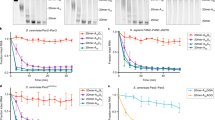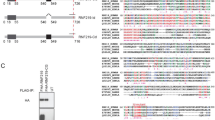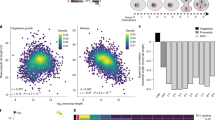Abstract
Dynamic changes of the lengths of mRNA poly(A) tails are catalysed by diverse deadenylase enzymes. Modulating the length of the poly(A) tail of an mRNA is a widespread means of controlling protein production and mRNA stability. Recent insights illuminate the specialized activities, biological functions and regulation of deadenylases. We propose that the recruitment of multifunctional deadenylase complexes provides unique opportunities to control mRNAs and that the heterogeneity of the deadenylase complexes is exploited to control translation and mRNA stability.
This is a preview of subscription content, access via your institution
Access options
Subscribe to this journal
Receive 12 print issues and online access
$189.00 per year
only $15.75 per issue
Buy this article
- Purchase on Springer Link
- Instant access to full article PDF
Prices may be subject to local taxes which are calculated during checkout



Similar content being viewed by others
References
Mathews, M. B., Sonenberg, N. & Hershey, J. W. B. (eds) Translational Control in Biology and Medicine (Cold Spring Harbor Laboratory Press, Cold Spring Harbor, 2007).
Zhao, J., Hyman, L. & Moore, C. Formation of mRNA 3′ ends in eukaryotes: mechanism, regulation, and interrelationships with other steps in mRNA synthesis. Microbiol Mol. Biol. Rev. 63, 405–445 (1999).
Gorgoni, B. & Gray, N. K. The roles of cytoplasmic poly(A)-binding proteins in regulating gene expression: a developmental perspective. Brief Funct. Genomics Proteomics 3, 125–141 (2004).
Garneau, N. L., Wilusz, J. & Wilusz, C. J. The highways and byways of mRNA decay. Nature Rev. Mol. Cell Biol. 8, 113–126 (2007).
Colegrove-Otero, L. J., Minshall, N. & Standart, N. RNA-binding proteins in early development. Crit. Rev. Biochem. Mol. Biol. 40, 21–73 (2005).
Lackner, D. H. et al. A network of multiple regulatory layers shapes gene expression in fission yeast. Mol. Cell 26, 145–155 (2007).
Beilharz, T. H. & Preiss, T. Widespread use of poly(A) tail length control to accentuate expression of the yeast transcriptome. RNA 13, 982–997 (2007).
Funakoshi, Y. et al. Mechanism of mRNA deadenylation: evidence for a molecular interplay between translation termination factor eRF3 and mRNA deadenylases. Genes Dev. 21, 3135–3148 (2007).
Doma, M. K. & Parker, R. RNA quality control in eukaryotes. Cell 131, 660–668 (2007).
Bianchin, C., Mauxion, F., Sentis, S., Seraphin, B. & Corbo, L. Conservation of the deadenylase activity of proteins of the Caf1 family in human. RNA 11, 487–494 (2005).
Thore, S., Mauxion, F., Seraphin, B. & Suck, D. X-ray structure and activity of the yeast Pop2 protein: a nuclease subunit of the mRNA deadenylase complex. EMBO Rep. 4, 1150–1155 (2003).
Zuo, Y. & Deutscher, M. P. Exoribonuclease superfamilies: structural analysis and phylogenetic distribution. Nucleic Acids Res. 29, 1017–1026 (2001).
Dlakic, M. Functionally unrelated signalling proteins contain a fold similar to Mg2+-dependent endonucleases. Trends Biochem. Sci. 25, 272–273 (2000).
Liu, Q., Greimann, J. C. & Lima, C. D. Reconstitution, activities, and structure of the eukaryotic RNA exosome. Cell 127, 1223–1237 (2006).
Dupressoir, A. et al. Identification of four families of yCCR4- and Mg2+-dependent endonuclease-related proteins in higher eukaryotes, and characterization of orthologs of yCCR4 with a conserved leucine-rich repeat essential for hCAF1/hPOP2 binding. BMC Genomics 2, 9 (2001).
Wagner, E., Clement, S. L. & Lykke-Andersen, J. An unconventional human CCR4–CAF1 deadenylase complex in nuclear cajal bodies. Mol. Cell Biol. 27, 1686–1695 (2007).
Faber, A. W., Van Dijk, M., Raue, H. A. & Vos, J. C. Ngl2p is a Ccr4p-like RNA nuclease essential for the final step in 3′-end processing of 5.8S rRNA in Saccharomyces cerevisiae. RNA 8, 1095–1101 (2002).
Kubota, K. et al. Identification of 2′-phosphodiesterase, which plays a role in the 2–5A system regulated by interferon. J. Biol. Chem. 279, 37832–37841 (2004).
Tucker, M. et al. The transcription factor associated Ccr4 and Caf1 proteins are components of the major cytoplasmic mRNA deadenylase in Saccharomyces cerevisiae. Cell 104, 377–386 (2001).
Yamashita, A. et al. Concerted action of poly(A) nucleases and decapping enzyme in mammalian mRNA turnover. Nature Struct. Mol. Biol. 12, 1054–1063 (2005).
Wu, M. et al. Structural insight into poly(A) binding and catalytic mechanism of human PARN. EMBO J. 24, 4082–4093 (2005).
Denis, C. L. & Chen, J. The CCR4–NOT complex plays diverse roles in mRNA metabolism. Prog. Nucleic Acid Res. Mol. Biol. 73, 221–250 (2003).
Morita, M. et al. Depletion of mammalian CCR4b deadenylase triggers elevation of the p27Kip1 mRNA level and impairs cell growth. Mol. Cell Biol. 27, 4980–4990 (2007).
Goldstrohm, A. C., Hook, B. A., Seay, D. J. & Wickens, M. PUF proteins bind Pop2p to regulate messenger RNAs. Nature Struct. Mol. Biol. 13, 533–539 (2006).
Morel, A. P. et al. BTG2 antiproliferative protein interacts with the human CCR4 complex existing in vivo in three cell-cycle-regulated forms. J. Cell Sci. 116, 2929–2936 (2003).
Kadyrova, L. Y., Habara, Y., Lee, T. H. & Wharton, R. P. Translational control of maternal Cyclin B mRNA by Nanos in the Drosophila germline. Development 134, 1519–1527 (2007).
Korner, C. G. et al. The deadenylating nuclease (DAN) is involved in poly(A) tail removal during the meiotic maturation of Xenopus oocytes. EMBO J. 17, 5427–5437 (1998).
Molin, L. & Puisieux, A. C. elegans homologue of the Caf1 gene, which encodes a subunit of the CCR4–NOT complex, is essential for embryonic and larval development and for meiotic progression. Gene 358, 73–81 (2005).
Morris, J. Z., Hong, A., Lilly, M. A. & Lehmann, R. Twin, a CCR4 homolog, regulates cyclin poly(A) tail length to permit Drosophila oogenesis. Development 132, 1165–1174 (2005).
Chiba, Y. et al. AtPARN is an essential poly(A) ribonuclease in Arabidopsis. Gene 328, 95–102 (2004).
Reverdatto, S. V., Dutko, J. A., Chekanova, J. A., Hamilton, D. A. & Belostotsky, D. A. mRNA deadenylation by PARN is essential for embryogenesis in higher plants. RNA 10, 1200–1214 (2004).
Berthet, C. et al. CCR4-associated factor CAF1 is an essential factor for spermatogenesis. Mol. Cell Biol. 24, 5808–5820 (2004).
Nakamura, T. et al. Oligo-astheno-teratozoospermia in mice lacking CNOT7, a regulator of retinoid X receptor β. Nature Genet. 36, 528–533 (2004).
Washio-Oikawa, K. et al. Cnot7-null mice exhibit high bone mass phenotype and modulation of BMP actions. J. Bone Miner. Res. 22, 1217–1223 (2007).
Green, C. B. et al. Loss of Nocturnin, a circadian deadenylase, confers resistance to hepatic steatosis and diet-induced obesity. Proc. Natl Acad. Sci. USA 104, 9888–9893 (2007).
Bjorklund, M. et al. Identification of pathways regulating cell size and cell-cycle progression by RNAi. Nature 439, 1009–1013 (2006).
Bogdan, J. A. et al. Human carbon catabolite repressor protein (CCR4)-associative factor 1: cloning, expression and characterization of its interaction with the B-cell translocation protein BTG1. Biochem. J. 336, 471–481 (1998).
Lejeune, F., Li, X. & Maquat, L. E. Nonsense-mediated mRNA decay in mammalian cells involves decapping, deadenylating, and exonucleolytic activities. Mol. Cell 12, 675–687 (2003).
Chen, C. Y. & Shyu, A. B. Rapid deadenylation triggered by a nonsense codon precedes decay of the RNA body in a mammalian cytoplasmic nonsense-mediated decay pathway. Mol. Cell Biol. 23, 4805–4813 (2003).
Green, C. B. & Besharse, J. C. Identification of a novel vertebrate circadian clock-regulated gene encoding the protein nocturnin. Proc. Natl Acad. Sci. USA 93, 14884–14888 (1996).
Prevot, D. et al. Relationships of the antiproliferative proteins BTG1 and BTG2 with CAF1, the human homolog of a component of the yeast CCR4 transcriptional complex: involvement in estrogen receptor alpha signaling pathway. J. Biol. Chem. 276, 9640–9648 (2001).
Gowrishankar, G. et al. Inhibition of mRNA deadenylation and degradation by different types of cell stress. Biol. Chem. 387, 323–327 (2006).
Hilgers, V., Teixeira, D. & Parker, R. Translation-independent inhibition of mRNA deadenylation during stress in Saccharomyces cerevisiae. RNA 12, 1835–1845 (2006).
Bonisch, C., Temme, C., Moritz, B. & Wahle, E. Degradation of hsp70 and other mRNAs in Drosophila via the 5′–3′ pathway and its regulation by heat shock. J. Biol. Chem. 282, 21818–21828 (2007).
Eulalio, A., Behm-Ansmant, I. & Izaurralde, E. P bodies: at the crossroads of post-transcriptional pathways. Nature Rev. Mol. Cell Biol. 8, 9–22 (2007).
Teixeira, D. & Parker, R. Analysis of P-body assembly in Saccharomyces cerevisiae. Mol. Biol. Cell 18, 2274–2287 (2007).
Conrad, N. K., Shu, M. D., Uyhazi, K. E. & Steitz, J. A. Mutational analysis of a viral RNA element that counteracts rapid RNA decay by interaction with the polyadenylate tail. Proc. Natl Acad. Sci. USA 104, 10412–10417 (2007).
Muhlrad, D. & Parker, R. The yeast EDC1 mRNA undergoes deadenylation-independent decapping stimulated by Not2p, Not4p, and Not5p. EMBO J. 24, 1033–1045 (2005).
Kim, J. H. & Richter, J. D. Opposing polymerase-deadenylase activities regulate cytoplasmic polyadenylation. Mol. Cell 24, 173–183 (2006).
Moraes, K. C., Wilusz, C. J. & Wilusz, J. CUG-BP binds to RNA substrates and recruits PARN deadenylase. RNA 12, 1084–1091 (2006).
Ezzeddine, N. et al. Human TOB, an antiproliferative transcription factor, is a PABP-dependent positive regulator of cytoplasmic mRNA deadenylation. Mol. Cell Biol. 27, 7791–7801 (2007).
Hook, B. A., Goldstrohm, A. C., Seay, D. J. & Wickens, M. Two yeast PUF proteins negatively regulate a single mRNA. J. Biol. Chem. 282, 15430–15438 (2007).
Briata, P. et al. p38-dependent phosphorylation of the mRNA decay-promoting factor KSRP controls the stability of select myogenic transcripts. Mol. Cell 20, 891–903 (2005).
Zaessinger, S., Busseau, I. & Simonelig, M. Oskar allows nanos mRNA translation in Drosophila embryos by preventing its deadenylation by Smaug/CCR4. Development 133, 4573–4583 (2006).
Mangus, D. A. et al. Positive and negative regulation of poly(A) nuclease. Mol. Cell Biol. 24, 5521–5533 (2004).
Tucker, M., Staples, R. R., Valencia-Sanchez, M. A., Muhlrad, D. & Parker, R. Ccr4p is the catalytic subunit of a Ccr4p–Pop2p–Notp mRNA deadenylase complex in Saccharomyces cerevisiae. EMVO J. 21, 1427–1436 (2002).
Korner, C. G. & Wahle, E. Poly(A) tail shortening by a mammalian poly(A)-specific 3′-exoribonuclease. J. Biol. Chem. 272, 10448–10456 (1997).
Voeltz, G. K., Ongkasuwan, J., Standart, N. & Steitz, J. A. A novel embryonic poly(A) binding protein, ePAB, regulates mRNA deadenylation in Xenopus egg extracts. Genes Dev. 15, 774–788 (2001).
Yao, G. et al. PAB1 self-association precludes its binding to poly(A), thereby accelerating CCR4 deadenylation in vivo. Mol. Cell Biol. 27, 6243–6253 (2007).
Simon, E. & Seraphin, B. A specific role for the C-terminal region of the poly(A)-binding protein in mRNA decay. Nucleic Acids Res. 35, 6017–6028 (2007).
Balatsos, N. A., Nilsson, P., Mazza, C., Cusack, S. & Virtanen, A. Inhibition of mRNA deadenylation by the nuclear cap binding complex (CBC). J. Biol. Chem. 281, 4517–4522 (2006).
Tran, H., Schilling, M., Wirbelauer, C., Hess, D. & Nagamine, Y. Facilitation of mRNA deadenylation and decay by the exosome-bound, DExH protein RHAU. Mol. Cell 13, 101–111 (2004).
Cao, D. & Parker, R. Computational modeling of eukaryotic mRNA turnover. RNA 7, 1192–1212 (2001).
Seal, R., Temperley, R., Wilusz, J., Lightowlers, R. N. & Chrzanowska-Lightowlers, Z. M. Serum-deprivation stimulates cap-binding by PARN at the expense of eIF4E, consistent with the observed decrease in mRNA stability. Nucleic Acids Res. 33, 376–387 (2005).
Standart, N. & Jackson, R. J. MicroRNAs repress translation of m7Gppp-capped target mRNAs in vitro by inhibiting initiation and promoting deadenylation. Genes Dev. 21, 1975–1982 (2007).
Behm-Ansmant, I. et al. mRNA degradation by miRNAs and GW182 requires both CCR4:NOT deadenylase and DCP1:DCP2 decapping complexes. Genes Dev. 20, 1885–1898 (2006).
Chu, C. Y. & Rana, T. M. Translation repression in human cells by microRNA-induced gene silencing requires RCK/p54. PLoS Biol. 4, e210 (2006).
Viswanathan, P., Ohn, T., Chiang, Y. C., Chen, J. & Denis, C. L. Mouse CAF1 can function as a processive deadenylase/3′–5′-exonuclease in vitro but in yeast the deadenylase function of CAF1 is not required for mRNA poly(A) removal. J. Biol. Chem. 279, 23988–23995 (2004).
Westmoreland, T. J. et al. Cell cycle progression in G1 and S phases is CCR4 dependent following ionizing radiation or replication stress in Saccharomyces cerevisiae. Eukaryot. Cell 3, 430–446 (2004).
Uchida, N., Hoshino, S. & Katada, T. Identification of a human cytoplasmic poly(A) nuclease complex stimulated by poly(A)-binding protein. J. Biol. Chem. 279, 1383–1391 (2004).
Baggs, J. E. & Green, C. B. Nocturnin, a deadenylase in Xenopus laevis retina: a mechanism for posttranscriptional control of circadian-related mRNA. Curr. Biol. 13, 189–198 (2003).
Gherzi, R. et al. A KH domain RNA binding protein, KSRP, promotes ARE-directed mRNA turnover by recruiting the degradation machinery. Mol. Cell 14, 571–583 (2004).
Chou, C. F. et al. Tethering KSRP, a decay-promoting AU-rich element-binding protein, to mRNAs elicits mRNA decay. Mol. Cell Biol. 26, 3695–3706 (2006).
Semotok, J. L. et al. Smaug recruits the CCR4–POP2–NOT deadenylase complex to trigger maternal transcript localization in the early Drosophila embryo. Curr. Biol. 15, 284–294 (2005).
Lykke-Andersen, J. & Wagner, E. Recruitment and activation of mRNA decay enzymes by two ARE-mediated decay activation domains in the proteins TTP and BRF-1. Genes Dev. 19, 351–361 (2005).
Chang, T. C. et al. UNR, a new partner of poly(A)-binding protein, plays a key role in translationally coupled mRNA turnover mediated by the c-fos major coding-region determinant. Genes Dev. 18, 2010–2023 (2004).
Acknowledgements
We appreciate discussions and input from E. Lund, J. Dahlberg, J. Lykke-Andersen and members of the Wickens laboratory. We thank L. Vanderploeg for assistance with artwork. We apologize to those authors whose work we could not cite owing to space limitations.
Author information
Authors and Affiliations
Corresponding author
Supplementary information
Supplementary information S1 (table)
Deadenylase nomeclature (PDF 173 kb)
Supplementary information S2 (figure)
Deadenylase complexes (PDF 251 kb)
Related links
Rights and permissions
About this article
Cite this article
Goldstrohm, A., Wickens, M. Multifunctional deadenylase complexes diversify mRNA control. Nat Rev Mol Cell Biol 9, 337–344 (2008). https://doi.org/10.1038/nrm2370
Issue Date:
DOI: https://doi.org/10.1038/nrm2370
This article is cited by
-
Short poly(A) tails are protected from deadenylation by the LARP1–PABP complex
Nature Structural & Molecular Biology (2023)
-
Terminal hairpins improve protein expression in IRES-initiated mRNA in the absence of a cap and polyadenylated tail
Gene Therapy (2023)
-
Roles of mRNA poly(A) tails in regulation of eukaryotic gene expression
Nature Reviews Molecular Cell Biology (2022)
-
ANGEL2 phosphatase activity is required for non-canonical mitochondrial RNA processing
Nature Communications (2022)
-
An atlas of plant full-length RNA reveals tissue-specific and monocots–dicots conserved regulation of poly(A) tail length
Nature Plants (2022)



